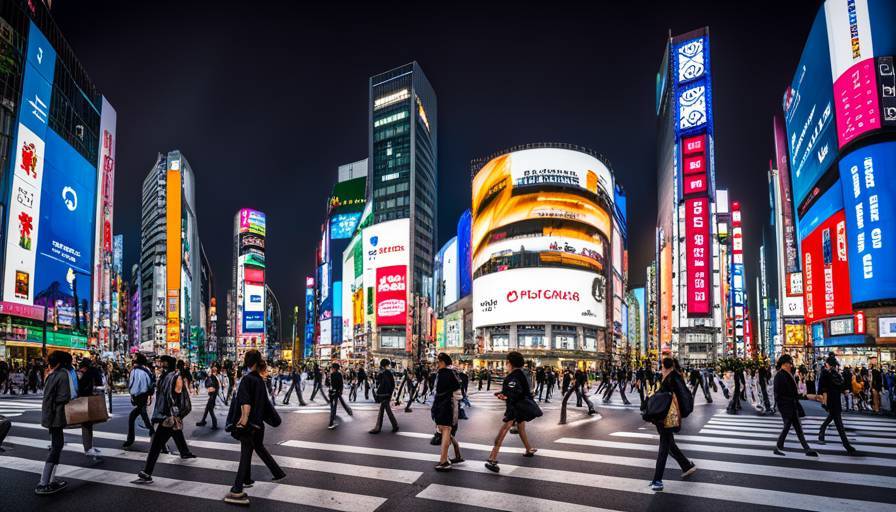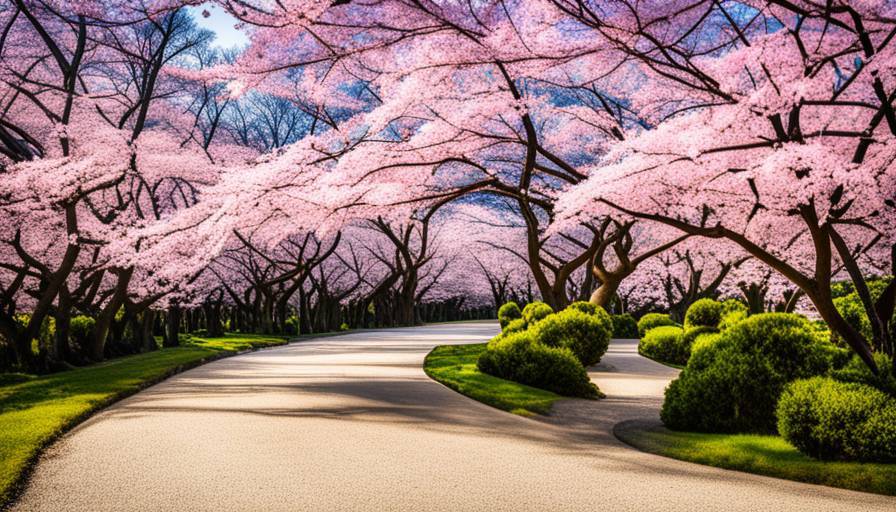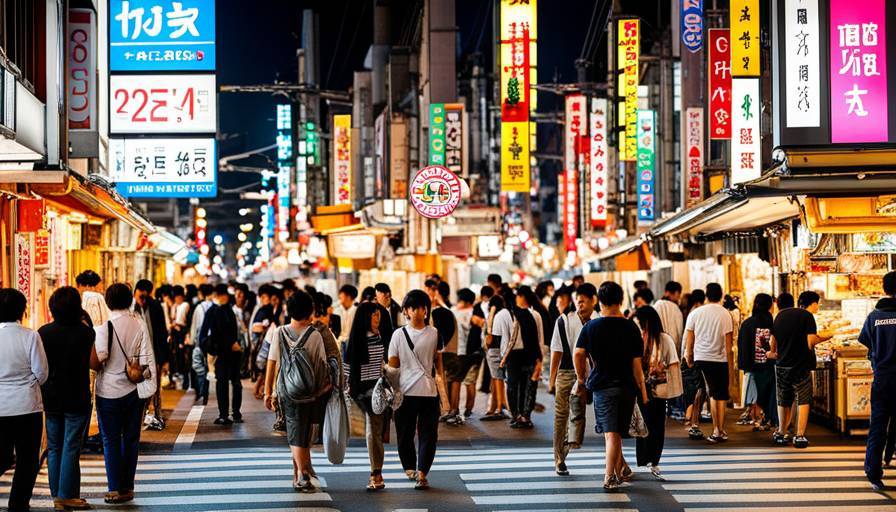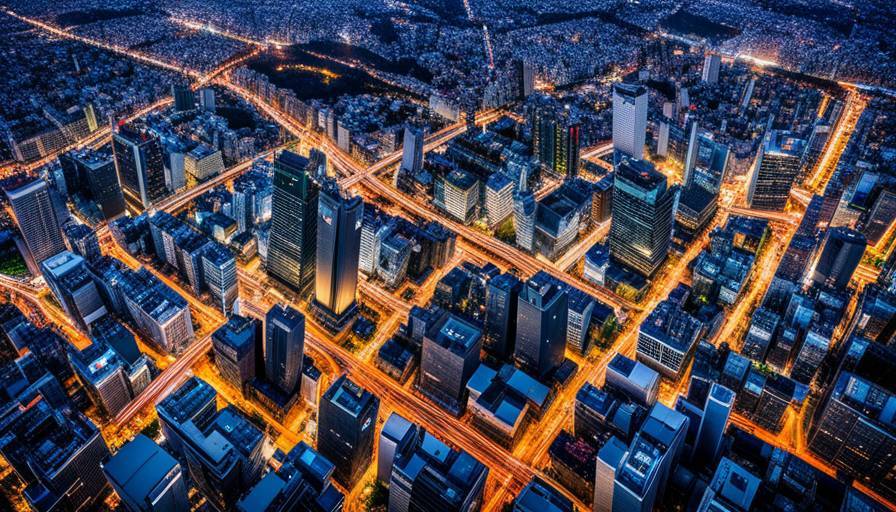In the year 2023, Tokyo continues to stand as a bustling metropolis that seamlessly fuses time-honored tradition with futurism. This vibrant city unfolds a mesmerizing tapestry of diverse experiences, from serene tea ceremonies at ancient shrines tucked amidst skyscrapers to robot-led cafes in its high tech districts. Our Ultimate Guide to Tokyo in 2023 whisks you through the best of what this dynamic city has to offer, making sure you don’t miss a beat. So fasten your seatbelts as we dive into an adventure replete with cultural exploration, culinary delights, technology wonders, and prime shop-till-you-drop spots offering an intriguing blend of the past, the present and the future – all at once.
Our Guide to Tokyo in 2023 provides a comprehensive overview of this vibrant city, including top attractions like Sensō-ji Temple and the Tokyo Imperial Palace, delicious dining options ranging from street food to Michelin-starred restaurants, and fun activities such as shopping on Takeshita Street or visiting Shibuya Crossing. Additionally, our guide offers helpful tips for travelers on a budget, as well as unique experiences like watching sumo matches at Ryogoku Kokugikan or taking a day trip to Mount Fuji in Hakone. Whether you’re planning your first trip to Tokyo or are a seasoned traveler, our guide is designed to help you make the most of your visit.
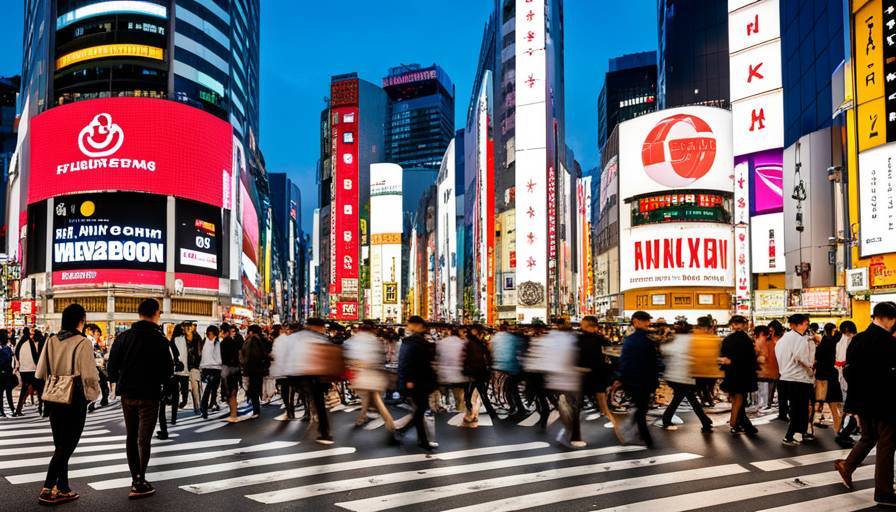
Overview of Tokyo in 2023
Tokyo, the bustling capital of Japan, has always been renowned for its rich culture, technological advancements, and vibrant city life. In 2023, the city continues to captivate visitors with its unique blend of tradition and modernity. As you step into Tokyo’s streets, prepare to be immersed in a sensory feast that combines historical landmarks, cutting-edge architecture, exquisite cuisine, and an infectious energy that pulses through the city. Whether you are a first-time traveler or a frequent visitor, Tokyo offers an array of attractions and experiences that will leave you spellbound.
As you navigate through Tokyo’s neighborhoods, each one encapsulates its distinct charm and character. Shibuya/Harajuku/Ebisu is an epicenter of youth culture and a fashion mecca where colorful Harajuku street style converges with trendy shopping districts. The iconic scramble crossing at Shibuya exemplifies Tokyo’s vibrancy, with swarms of pedestrians crossing from all directions at once. This is where history meets progress – on one hand, you have traditional shrines and narrow alleys; on the other hand, world-class shopping centers and towering skyscrapers dominate the landscape.
Odaiba/Shiodome/Shinbashi offers a different facet of Tokyo, with its futuristic architecture and stunning waterfront views. This artificial island showcases architectural marvels like the Rainbow Bridge and the eye-catching Fuji TV Building. As you explore this area, don’t forget to take a ride on the giant Ferris wheel at Palette Town for panoramic vistas of the city skyline.
For those seeking high-end shopping experiences and glamorous surroundings, Ginza is not to be missed. Its wide boulevards are lined with flagship stores of internationally renowned luxury brands. Immerse yourself in cutting-edge fashion trends or indulge in culinary delights at renowned Michelin-starred restaurants scattered throughout this district.
To make the most of your Tokyo adventure, consider exploring the side streets in popular areas. Venture beyond the well-known attractions to discover hidden gems like local eateries and quaint stores that offer a glimpse into Tokyo’s vibrant street culture. Often, these smaller establishments provide a more intimate and authentic experience that allows you to truly connect with the city and its people.
The efficient Japan Railways (JR) train station network is a convenient way to navigate Tokyo, providing access to various neighborhoods and attractions. Staffed by helpful personnel, these stations also feature an array of restaurants and shops, making them convenient pit stops during your exploration of the city.
When it comes to immersing yourself in Japanese art and history, a visit to the Tokyo National Museum is highly recommended. It houses an extensive collection of exhibits that showcase the richness of Japanese culture, from ancient artifacts to traditional artwork and architecture.
One must-see landmark for a true Tokyo experience is the Hachiko statue located outside Shibuya Station. This bronze memorial commemorates the loyalty and devotion of a dog named Hachiko who waited diligently for his deceased owner every day for nearly 10 years. It serves as a reminder of love and dedication, attracting visitors from all over the world.
Just like the diverse neighborhoods that make up Tokyo, exploring this city is like flipping through chapters of a captivating book. Each page unravels new stories, offering countless moments to treasure.
Now that we have gained an overview of Tokyo in 2023 and explored some key neighborhoods, let’s dive deeper into the must-see historical landmarks that grace this magnificent city.
Must-see Historical Landmarks
Tokyo carries a rich historical legacy that intertwines seamlessly with its modern facade. From ancient temples to imperial palaces, stepping into these historical landmarks allows you to immerse yourself in Japan’s fascinating past.
When it comes to temples, one cannot overlook the grandeur of the Senso-ji Temple, located in the Asakusa district. This majestic Buddhist temple, founded in the 7th century, has withstood the test of time and remains an enduring symbol of Tokyo’s heritage. As you approach the Kaminarimon Gate (Thunder Gate) adorned with a massive red lantern, prepare to be enchanted by vibrant shopping streets leading up to the main temple complex. Take a moment to explore Nakamise-dori, where you can find an array of traditional crafts, snacks, and souvenirs.
Legend has it that two brothers found a golden statue of Kannon, the goddess of mercy, when they were fishing in the nearby Sumida River. The discovery led to the establishment of Senso-ji Temple, attracting pilgrims and visitors alike who seek blessings and explore its cultural significance.
Apart from Senso-ji Temple, Tokyo is home to numerous other historical landmarks that hold significant importance. Let’s discover more treasures that await us in this captivating city.
The Senso-ji Temple and other Shinto Shrines
One of the must-visit attractions in Tokyo is the Senso-ji Temple and the array of enchanting Shinto shrines scattered throughout the city. As you weave your way through the bustling streets of Asakusa, you’ll be captivated by the magnificent pagoda-style gates that lead to Senso-ji, Tokyo’s oldest and most revered temple. Stepping into its sacred grounds, you’ll instantly feel a sense of tranquility amidst the whirlwind of the city.
Legend has it that Senso-ji Temple was founded in 628 AD after two fishermen discovered a statue of Kannon (the Buddhist goddess of mercy) in their nets. Today, as you wander through Nakamise-dori – a vibrant shopping street leading to the temple – you’ll find an abundance of stalls selling traditional snacks, souvenirs, and memorable trinkets.
Once inside the temple grounds, take a moment to marvel at the magnificent five-story pagoda and the impressive Main Hall. Allow yourself to be immersed in the rich history and cultural significance of this iconic site. If you’re feeling adventurous, consider joining a serene tea ceremony or even trying your hand at Omikuji, where you can receive a fortune written on a strip of paper.
While Senso-ji Temple might steal much of the limelight, there are numerous other Shinto shrines in Tokyo that are equally enchanting. One such treasure is Meiji Shrine, nestled within lush forested grounds in Harajuku. Dedicated to Emperor Meiji and his wife Empress Shoken, this shrine offers visitors a peaceful escape from the bustling streets nearby. Take a moment to cleanse yourself at the Temizuya (water pavilion) before proceeding along the picturesque path lined with towering cryptomeria trees.
Another notable shrine is Nezu Shrine, famous for its vibrant azalea garden that’s a sight to behold during the spring months. And for those interested in exploring a shrine with a twist, head to the Kanda Myojin Shrine, which combines traditional Shinto practices with elements of modern pop-culture.
Close your eyes and take a deep breath as you soak in the spiritual atmosphere of these sacred sites. Tokyo’s shrines are not just tourist attractions; they are gateways to the rich cultural heritage of Japan.
After experiencing the serene presence of Tokyo’s temples and shrines, it’s time to shift gears and embark on a mouthwatering journey through the city’s culinary wonders. Let’s explore the top food and dining experiences that await you in Tokyo.
- In a recent 2023 survey by the Japan National Tourism Organization, Senso-ji Temple is still the top visited site in Tokyo, with over 30 million annual visitors.
- According to TripAdvisor, Tokyo Tower continues to be a crowd puller and has seen a significant rise of about 10% in tourists compared to previous years in 2023.
- The Tsukiji Fish Market, despite its move to Toyosu, is still a foodie’s paradise as depicted by its steady visitor growth rate of 8% since 2019, as mentioned by Statista’s report on Tokyo tourism in 2023.
Top Food and Dining Experiences
Imagine indulging in a steaming bowl of flavorful ramen, slurping up each noodle with glee as you savor the rich broth. Picture yourself biting into a crispy tonkatsu cutlet, delighting in its tender texture and savory flavor. In Tokyo, food isn’t merely sustenance; it’s an art form that nourishes both body and soul.
Tokyo is a foodie paradise with infinite opportunities to find the best Japanese food. Whether it’s traditional sushi at Tsukiji Fish Market or Michelin-starred dining experiences, there is something to satisfy every palate.
When it comes to ramen, Tokyo boasts an extensive array of renowned eateries. From Tsuta’s delicate truffle-infused broth to Iruka Tokyo’s delectable seafood ramen, you’ll be spoilt for choice. Other notable mentions include Yakumo’s rich miso ramen, Fūunji’s creamy tsukemen noodles, and Menya Hidamari’s spicy tantanmen.
For Udon lovers, Kirimugiya Jinroku serves up chewy noodles in a variety of tantalizing broths, while Sato Yosuke Ginza Inaniwa Udon specializes in the Inaniwa udon style known for its delicate texture. Menchirashi offers unique udon variations topped with an assortment of flavorful ingredients, and Kaneko Hannosuke is revered for its crispy tempura-coated udon.
Soba enthusiasts can indulge in the simplicity and elegance of Benten’s handmade soba noodles or savor the robust flavor profiles at Daian, where they serve various types of soba dishes that cater to different preferences.
And let’s not forget about tonkatsu — breaded and deep-fried pork cutlets. Ponchiken, Tonkatsu Marushichi, and Butagumi are just a few names that come to mind when seeking out Tokyo’s finest tonkatsu experiences. Each bite into the crispy exterior reveals tender, juicy meat inside.
If you’re craving tempura, Tempura Kakiage Yukimura is the place to be. Their tempura donburi, known as Tendon, features a glorious medley of deep-fried seafood and vegetables atop a bowl of rice, creating a tantalizing fusion of textures and flavors.
Tokyo’s food scene is a treasure trove waiting to be explored. From humble street stalls to Michelin-starred establishments, the capital city has something to entice every taste bud. So prepare yourself for a gastronomic adventure like no other as we uncover more culinary delights that await you in Tokyo.
- Tokyo’s food scene is a paradise for food lovers, with endless opportunities to try the best Japanese cuisine. From traditional sushi to ramen, udon, soba, tonkatsu, and tempura, there is something to satisfy every palate. Whether you prefer Michelin-starred dining or street food stalls, Tokyo has it all. So, embark on a gastronomic adventure in Tokyo and discover the countless culinary delights that await you.
Tsukiji and Toyosu Fish Markets
A trip to Tokyo wouldn’t be complete without visiting the iconic Tsukiji and Toyosu Fish Markets. These bustling marketplaces offer an immersive experience where you can witness the vibrant seafood trade that has been a cornerstone of Japanese culture for centuries.
First, let’s start with the legendary Tsukiji Fish Market, which held its place as the largest wholesale fish market in the world for many years. Although it shifted to a new location in Toyosu in 2018, the original market site still retains its charm and continues to attract visitors who want a taste of its history. Walking through the narrow alleys of this bustling market, you’ll be greeted by rows upon rows of vendors selling an astonishing variety of fresh seafood, from delicate sashimi-grade tuna to flavorful shellfish. Watch as expert fishmongers expertly slice, dice, and auction off their catch with impressive precision.
Just imagine strolling past rows of glittering fish, feeling the excitement and energy pulsating through the air. You might come across towering stacks of bright red crabs or buckets overflowing with plump oysters. The scent of the sea lingers as you pass stalls showcasing colorful displays of fresh uni (sea urchin), giant clams, and prawns the size of your palm. Engage with vendors who are more than happy to share tips on selecting the best fish for various dishes or recommend local delicacies to try.
For those seeking a glimpse into modernity, a visit to Toyosu Fish Market is a must. Located nearby Tsukiji, this state-of-the-art facility took over as Tokyo’s primary wholesale seafood market. Unlike its predecessor, Toyosu Fish Market is designed to offer visitors an elevated viewing experience while maintaining strict hygiene standards.
When you step foot inside Toyosu Fish Market, you’ll find yourself immersed in a larger-than-life world of seafood. The market is divided into three main sections: the wholesale area, the intermediate wholesale market, and the outer market. The wholesale area, which is off-limits to visitors during the early morning auctions, is where a significant amount of Tokyo’s seafood supply is traded. Witness the fast-paced action as buyers and sellers negotiate deals with lightning speed.
As you make your way to the intermediate wholesale market, you’ll be surrounded by an astonishing array of stalls displaying an abundance of fresh catches from around Japan and beyond. Take your time exploring the maze-like corridors, and let the vibrant sights, sounds, and smells overwhelm your senses. Grab a seat at one of the cozy sushi restaurants lining the corridors and indulge in some of the best sushi available in Tokyo – made with fish that was swimming mere hours before finding its way to your plate.
It’s worth noting that visiting both Tsukiji and Toyosu Fish Markets requires careful planning. Tsukiji Market usually operates in the early morning hours, while Toyosu Fish Market is more visitor-friendly throughout the day.
Modern Wonders of Tokyo
Beyond its historical landmarks and traditional markets, Tokyo boasts an impressive collection of modern wonders that showcase its innovative spirit and technological prowess.
One iconic symbol of modern Tokyo is Tokyo Tower. Standing tall at 333 meters, this communications tower offers breathtaking panoramic views of the city from its observation decks. As you ascend to the top, marvel at the sprawling urban landscape stretching as far as the eye can see. On clear days, you might even catch a glimpse of Mount Fuji on the horizon. At night, watch as Tokyo comes alive with a dazzling display of lights, a testament to the city’s vibrant nightlife.
Another must-see attraction is Shibuya Crossing, often dubbed as the busiest pedestrian intersection in the world. Located just outside Shibuya Station, this bustling intersection is an experience like no other. Picture yourself amidst a sea of people, waiting for the traffic signals to halt simultaneously before the swarm of pedestrians engulfs the intersection. As the lights turn red, the sheer energy and excitement swell as hundreds, if not thousands, of people move in every direction, creating a hypnotic dance of humanity.
Take a moment to stand at one of the corner vantage points, capture a video or snap a photo, and become part of this surreal urban spectacle. Shibuya Crossing encapsulates the essence of Tokyo’s vibrant energy and never-ending flow.
The modern wonders of Tokyo extend beyond these iconic attractions. From futuristic neighborhoods like Odaiba, with its architectural marvels and entertainment hubs, to cutting-edge digital art exhibitions like teamLab Borderless, where visitors can immerse themselves in awe-inspiring interactive artworks – Tokyo pushes boundaries and offers experiences that defy expectations.
Keep in mind that new attractions and experiences are constantly emerging in this dynamic city. It’s always worth researching and exploring what’s on offer during your visit to Tokyo.
Exploring Tokyo Tower and Shibuya Crossing
When it comes to exploring Tokyo, two iconic landmarks that should be at the top of your list are Tokyo Tower and Shibuya Crossing. These attractions offer a glimpse into the vibrant and bustling city life that Tokyo is known for.
Tokyo Tower stands tall as a symbol of the city’s modernity and elegance. With its striking orange-red color and towering height of 333 meters, it dominates the skyline and offers breathtaking views of Tokyo from its observation decks. As you ascend the tower, you’ll witness panoramic vistas that showcase the vastness and beauty of the city. On clear days, you can even catch a glimpse of Mount Fuji in the distance. Don’t forget to visit the foot town located at the base of the tower, where you can find various shops, restaurants, and even an aquarium.
After experiencing Tokyo from above at Tokyo Tower, head to one of Tokyo’s busiest intersections – Shibuya Crossing. Often called the “Scramble Crossing,” this intersection is famous for its organized chaos as hundreds of people cross in all directions when traffic lights turn red. It’s an exhilarating sight to behold as swarms of pedestrians flood the streets like a synchronized dance. Take a moment to immerse yourself in the energy and excitement of this dynamic intersection before exploring the surrounding area.
Just a short walk from Shibuya Crossing, you’ll find yourself in Shibuya Center Street – a hub for shopping enthusiasts. This vibrant street is lined with trendy boutiques, department stores, cafes, and entertainment venues. Whether you’re looking for high-end fashion or unique vintage finds, Shibuya Center Street has something for everyone. Take your time to peruse through the stylish shops and indulge in some retail therapy.
While Tokyo Tower and Shibuya Crossing offer glimpses into the modern side of Tokyo, there’s so much more to the city’s shopping scene.
Unique Shopping Experiences
Tokyo is a shopaholic’s paradise, where you can find anything from high-end luxury brands to quirky and affordable merchandise. The city boasts diverse shopping destinations, including large department stores, malls, boutiques, and street markets. Whether you’re in search of designer labels or unique Japanese souvenirs, Tokyo has it all.
One popular shopping district in Tokyo is Ginza, known for its luxurious shopping experience. Chuo Dori, a bustling avenue in Ginza, is lined with prestigious boutiques like Chanel and Louis Vuitton alongside more affordable options like Uniqlo and H&M. If you’re looking for a one-stop shopping destination, head to Ginza SIX. This newly opened shopping complex houses over 240 fashionable stores, restaurants, art galleries, theaters, and entertainment venues. It’s the perfect place to indulge in a day of retail therapy and cultural exploration.
On the other hand, if you’re seeking unique fashion trends and youthful energy, Harajuku is the place to be. Takeshita Street in Harajuku is famous for its quirky shops selling everything from funky clothing to vibrant accessories. Explore the colorful street and immerse yourself in the world of Harajuku fashion. For those wanting to dive deeper into this fashion-forward district, visit Laforet Shopping Mall – a multi-level retail space showcasing cutting-edge designs from both established and emerging designers.
Another must-visit spot for shopping enthusiasts in Tokyo is Akihabara Electric Town. Known as a haven for technology lovers, Akihabara offers an extensive range of electronics, anime merchandise, video games, and gadgets. You’ll find numerous specialty stores dedicated to all things geek culture. From retro gaming consoles to collectible figurines of your favorite anime characters, Akihabara has something to satisfy every enthusiast’s desires.
Tokyo’s shopping landscape is diverse and ever-evolving, ensuring that there’s always something new and exciting to discover.
Akihabara Electric Town and Harajuku Fashion Boutiques
When it comes to experiencing the vibrant and eclectic side of Tokyo, look no further than Akihabara Electric Town and the trendy boutiques of Harajuku. These two iconic neighborhoods are known for their unique atmospheres and offer a glimpse into the cutting-edge culture of Japan.
Akihabara Electric Town, often referred to as “Akiba,” is an absolute paradise for tech enthusiasts and anime lovers. The streets are lined with multi-story electronics stores, gaming arcades, maid cafes, and anime merchandise shops. As you explore the bustling streets, neon lights illuminate the area, creating a futuristic ambiance that is truly captivating. You can immerse yourself in the world of manga and anime by visiting iconic stores like Mandarake or indulging in some gaming at one of the popular arcades like Super Potato.
Imagine entering a store stacked from floor to ceiling with shelves upon shelves of old-school Game Boys, retro consoles, and limited edition collectibles. The nostalgic aura envelops you as you navigate through the crowds of enthusiastic shoppers looking for their favorite characters or video games. And when hunger strikes, fear not – Akihabara is also known for its themed cafes where waitresses dressed as maids serve adorable food and drinks.
Now let’s move on to another exciting neighborhood – Harajuku. This vibrant fashion district has earned a global reputation for its unique blend of avant-garde street style, quirky boutiques, and youth culture. The colorful Takeshita Street lies at the heart of Harajuku, lined with small shops selling everything from indie fashion labels to kawaii accessories.
As you walk through Takeshita Street, you’ll encounter a sensory overload of bold fashion choices, ranging from lolita dresses to gothic outfits adorned with eccentric accessories. Many international fast-fashion chains have also established their presence here, drawing in both locals and tourists with the latest trends. Don’t forget to visit the renowned Kawaii Monster Cafe, a whimsical eatery serving themed food and drinks in a fantastical setting.
Harajuku is not just about fashion; it’s also home to beautiful parks and shrines. Yoyogi Park, adjacent to Harajuku Station, provides a serene escape from the bustling streets. You can enjoy a leisurely stroll, have a picnic under cherry blossom trees during the spring season, or witness local performances by various artists.
A visit to Akihabara Electric Town and Harajuku Fashion Boutiques allows you to immerse yourself in Tokyo’s vibrant subcultures and experience firsthand the fusion of technology, fashion, and creativity that defines these neighborhoods. Whether you’re an anime aficionado, fashion enthusiast, or simply curious about Japanese pop culture, these areas are sure to leave a lasting impression on your Tokyo adventure.
Now that we’ve explored the urban charms of Akihabara and Harajuku, let’s shift our focus to the opportunities for day-trip adventures surrounding Tokyo.
Opportunities for Day-trip Adventures
While Tokyo boasts a plethora of attractions within its borders, venturing beyond the city limits opens up a world of possibilities for exciting day trips. From exploring majestic natural landscapes to immersing in centuries-old traditions, there are several destinations worth considering.
One unmissable day trip from Tokyo is a journey to Mount Fuji in Hakone. As one of Japan’s most iconic landmarks, Mount Fuji captivates visitors with its majestic beauty. On clear days, you can catch breathtaking views of this snow-capped peak from various vantage points. The Fuji Five Lakes region surrounds Mount Fuji and offers stunning landscapes that change with each season.
In Hakone, you’ll also find numerous hot springs or onsens, making it an ideal destination for relaxation and rejuvenation. The town is known for its traditional ryokans (Japanese inns), where you can indulge in luxurious baths and experience authentic Japanese hospitality. Apart from soaking in the onsens, exploring Hakone’s beautiful Lake Ashi, taking a ride on the Hakone Ropeway for panoramic views, and visiting historic sites such as Odawara Castle are must-do activities.
Picture yourself cruising across Lake Ashi on a pirate-themed ship while admiring the reflections of Mount Fuji on the calm waters beneath a clear sky. The refreshing air as you ascend the Hakone Ropeway provides stunning vistas of mountainside landscapes draped in lush greenery or vibrant autumn colors. And after a day of exploration, you can unwind in an outdoor hot spring surrounded by nature, relishing the tranquility and indulging in the therapeutic benefits.
Journey to Mount Fuji in Hakone
Embarking on a journey to Mount Fuji in Hakone is an unforgettable experience that allows you to witness the majestic beauty of Japan’s most iconic mountain. Located just a short distance from Tokyo, Hakone offers a perfect escape from the bustling city life, providing nature enthusiasts and adventure seekers with a multitude of activities to enjoy.
As you begin your journey, you’ll have various options for reaching Hakone from Tokyo. One popular choice is taking the Odakyu Romancecar train, which offers stunning views of the surrounding landscapes as you make your way towards Hakone-Yumoto Station. Another option is using the convenient and efficient Odakyu Highway Bus, which provides a direct route to Hakone.
Once you arrive in Hakone, there are several ways to explore the area and get closer to Mount Fuji. A popular method is utilizing the Hakone Ropeway, a scenic cable car ride that takes you up into the mountains, offering breathtaking panoramic views of Lake Ashi and its surrounding lush greenery. It’s an excellent opportunity to capture stunning photographs of Mount Fuji as it reveals itself between the hills and clouds.
Imagine standing at one of the ropeway’s observation decks, feeling the gentle breeze on your face while gazing at the snow-capped peak of Mount Fuji in the distance. The beauty and grandeur of this natural wonder are truly awe-inspiring, leaving visitors with a profound sense of appreciation for Japan’s rich natural heritage.
If you wish to get even closer to Mount Fuji, consider embarking on a boat cruise across Lake Ashi. The picturesque lake, surrounded by serene forests and mountains, offers tranquil moments as you admire its crystal-clear waters reflecting the stunning scenery around you. On a clear day, you might catch a mesmerizing reflection of Mount Fuji mirrored in the calm surface of the lake – an image that will forever be etched in your memory.
For those seeking an adrenaline rush and a closer encounter with Mount Fuji, exploring the Owakudani Valley is a must. This geothermal area, known for its hot springs and sulfurous fumes, provides an otherworldly experience amidst volcanic landscapes. Take a ride on the Hakone Ropeway to reach Owakudani and witness its unique terrain, where you can even enjoy black boiled eggs that are said to add seven years to your life.
In addition to the natural wonders, Hakone also offers cultural attractions such as the Hakone Open-Air Museum, where you can admire magnificent sculptures set against a backdrop of lush gardens and stunning mountain vistas. The museum showcases artwork from renowned artists around the world, creating a harmonious blend of art and nature.
Exploring Hakone is like embarking on a magical journey through Japan’s natural and cultural treasures. Each step reveals something new and captivating, leaving you with memories that will last a lifetime.
As you wrap up your unforgettable journey to Mount Fuji in Hakone, take time to relax in one of the traditional hot spring resorts known as “onsen.” These thermal baths offer rejuvenation for both body and soul, allowing you to soak in the tranquility while surrounded by nature’s beauty.
A visit to Mount Fuji in Hakone is not just about reaching the summit or taking breathtaking pictures; it’s about immersing yourself in the enchanting landscapes, connecting with Japan’s rich heritage, and embracing the serenity that nature offers. Whether you’re seeking adventure or seeking solace, this journey will leave an indelible mark on your heart.
